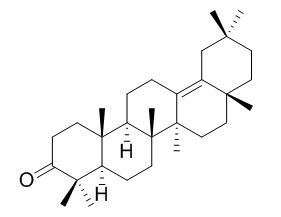13(18)-Oleanen-3-one
δ-Amyrone(13(18)-Oleanen-3-one), a specific inhibitor of cyclooxygenase-2, possesses anti-inflammatory effects, which may be relevant to the regulation of COX-2; it exerts its protective effect on experimental gastric ulcer by inhibiting NF-κB signaling pathways, which subsequently reduces overproduction of the inducible enzymes iNOS and suppresses the release of the inflammatory factors TNF-α, IL-6 and NO. δ-Amyrone has protective activity on LPS-induced endotoxic shock, which is attributed to reducing NO production and mediating the pro-inflammatory cytokines, inhibited NF-κB expression.
Inquire / Order:
manager@chemfaces.com
Technical Inquiries:
service@chemfaces.com
Tel:
+86-27-84237783
Fax:
+86-27-84254680
Address:
1 Building, No. 83, CheCheng Rd., Wuhan Economic and Technological Development Zone, Wuhan, Hubei 430056, PRC
Providing storage is as stated on the product vial and the vial is kept tightly sealed, the product can be stored for up to
24 months(2-8C).
Wherever possible, you should prepare and use solutions on the same day. However, if you need to make up stock solutions in advance, we recommend that you store the solution as aliquots in tightly sealed vials at -20C. Generally, these will be useable for up to two weeks. Before use, and prior to opening the vial we recommend that you allow your product to equilibrate to room temperature for at least 1 hour.
Need more advice on solubility, usage and handling? Please email to: service@chemfaces.com
The packaging of the product may have turned upside down during transportation, resulting in the natural compounds adhering to the neck or cap of the vial. take the vial out of its packaging and gently shake to let the compounds fall to the bottom of the vial. for liquid products, centrifuge at 200-500 RPM to gather the liquid at the bottom of the vial. try to avoid loss or contamination during handling.
Herbal Formula Science2024, 32(3):203-221
Sci Rep.2017, 7:40345
Allergol Immunopathol (Madr).2022, 1;50(4):23-30.
Research on Crops.2017, 18(3):569
Medicina (Kaunas).2020, 56(12):685.
J Agric Food Chem.2022, 70(51):16176-16187.
Chem Biol Interact.2024, 394:110995.
J Nat Prod.2022, 85(5):1351-1362.
Sustainable Chemistry & Pharmacy2022, 30:100883.
Vietnam Journal of Food Control.2022, 5(3):pp.488-497.
Related and Featured Products
Int Immunopharmacol. 2014 Jul;21(1):112-8.
δ-Amyrone, a specific inhibitor of cyclooxygenase-2, exhibits anti-inflammatory effects in vitro and in vivo of mice.[Pubmed:
24813716]
The whole plant of Sedum lineare Thunb has been used as traditional folk medicines for the treatment of sore throat, persistent hepatitis, jaundice and dysentery.
METHODS AND RESULTS:
δ-Amyrone (13(18)-Oleanen-3-one), a pentacyclic triterpene compound from S. lineare Thunb, was found to possess a potent anti-inflammatory effect in different inflammation model animals. Pretreatment with 13(18)-Oleanen-3-one (i.p.) inhibited the ear edema in xylene-induced mouse ear edema. 13(18)-Oleanen-3-one also decreased the level of nitric oxide (NO), prostaglandin E2 (PGE2), interleukin-6 (IL-6) and leukocyte numbers in acetic acid-induced peritonitis in vivo. To clarify the possible mechanism of 13(18)-Oleanen-3-one, we investigated the effect of 13(18)-Oleanen-3-one in lipopolysaccharide (LPS) induced peritoneal macrophages. The data indicated that 13(18)-Oleanen-3-one notably inhibited IL-6, TNF-α and NO production. In addition, the result showed that 13(18)-Oleanen-3-one may control the cyclooxygenase-2 (COX-2) regulation and not the cyclooxygenase-1 (COX-1) at protein levels.
CONCLUSIONS:
These results suggest that 13(18)-Oleanen-3-one is a bioactive agent which possesses anti-inflammatory effects, which may be relevant to the regulation of COX-2.
Immunobiology. 2015 Jun;220(6):798-806.
Protective effect of δ-amyrone against ethanol-induced gastric ulcer in mice.[Pubmed:
25572867 ]
The purpose of this study is to examine the protective effect of δ-amyrone(13(18)-Oleanen-3-one ) on ethanol-induced gastric ulcer in mice.
METHODS AND RESULTS:
The mice intragastric administration 75% (0.5 mL/100g) ethanol was pretreated with δ-amyrone (4 and 8 mg/kg) and cimetidine (100 mg/kg) or vehicles in different experimental groups for a continuous three-day, and animals were euthanized 3h after ethanol ingestion. The gastric lesions were significantly attenuated by δ-amyrone (4 and 8 mg/kg) as compared to the ulcer control group. Pre-treatment with δ-amyrone prevented the myeloperoxidase (MPO) activity, production of nitric oxide (NO) in serum, expression of inducible nitric oxide synthase (iNOS) and nuclear factor kappa B (NF-κB) p65 protein expression. Analysis of cytokines in gastric tissue and serum of ethanol-induced mice showed the levels of tumor necrosis factor-alpha (TNF-α) and interleukin-6 (IL-6) were decreased by δ-amyrone in response to NF-κB p65.
CONCLUSIONS:
These results suggested that δ-amyrone exerts its protective effect on experimental gastric ulcer by inhibiting NF-κB signaling pathways, which subsequently reduces overproduction of the inducible enzymes iNOS and suppresses the release of the inflammatory factors TNF-α, IL-6 and NO. Thus, δ-amyrone shows promise as a therapeutic agent in experimental gastric ulcer.
Chem Biol Interact. 2015 Oct 5;240:354-61.
δ-Amyrone inhibits lipopolysaccharide-induced inflammatory cytokines and protects against endotoxic shock in mice.[Pubmed:
26271896 ]
δ-Amyrone (13(18)-Oleanen-3-one), which is an active constituent extracted and separated from Sedum lineare Thunb., has been found to possess a potent anti-inflammatory effect in different inflammation model animals. But its effects on lipopolysaccharide (LPS)-induced endotoxic shock have not been previous explored. The aim of this study is to evaluate the effect of δ-Amyrone on LPS-induced inflammatory cytokines and the protective effect on endotoxic shock mice.
METHODS AND RESULTS:
Experimental animals received δ-amyrone (4 and 8 mg/kg, i.p.) and dexamethasone (DEX) (5 mg/kg, i.p.) at 24 and 1 h before LPS injection. δ-Amyrone treatment significantly decreased mortality rate, tissues myeloperoxodase (MPO) activity, p65 NF-κB protein expression when compared with the LPS groups. The levels of tumor nectosis factor-alphagene (TNF-α) and interleukin-6 (IL-6) both in serum and lung, liver, kidney tissues, as well as the accumulation of nitric oxide (NO) in serum were decreased by δ-amyrone in response to p65 nuclear factors-kappa B (NF-κB).
CONCLUSIONS:
These results suggest that the protective activity of δ-amyrone on LPS-induced endotoxic shock is attributed to reducing NO production and mediating the pro-inflammatory cytokines, inhibited NF-κB expression.



